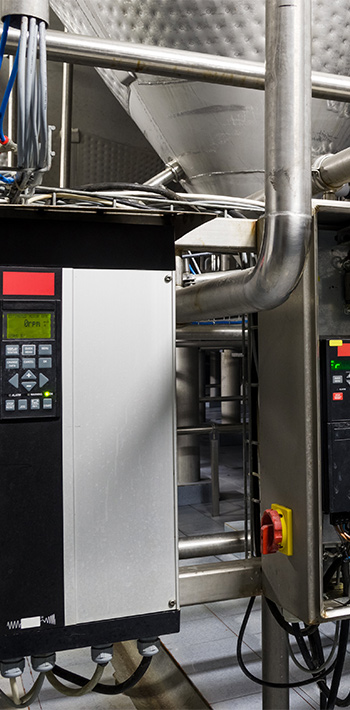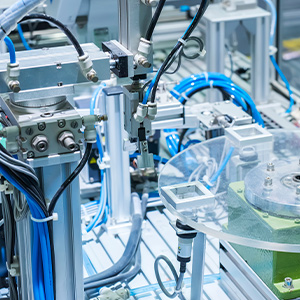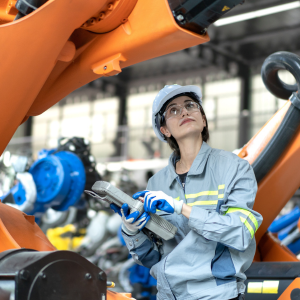Variable Speed Drives: An IIoT Tool That Benefits Manufacturers
Post By: Ryan King On: 31-01-2019 - Automation & Control - Industry 4.0 - Industry Trends
Global manufacturing today is a cut-throat game, with many challenges to be faced. Demand obviously fluctuates in accordance with prevailing socio-economic conditions, but everyone now expects higher and higher productivity and output levels, while at the same time requiring consistently high quality to be maintained. In addition, the mass customisation of goods is more commonly being looked for, and Original Equipment Manufacturers (OEMs) are having to produce machines that can support this style of supply. The manufacturing environment in the 21st century is therefore so competitive that the most successful OEMs are those who can deliver machines capable of continuous adaptation to the changing performances required by their end users.
Variable Speed Drives
Differing customer specifications require a flexible architecture capable of integrating into different systems, and of accommodating the appropriate infrastructure to assimilate the IIoT (Industrial Internet of Things). Successful OEMs must therefore be able to build machines in this way, but machines that also perform better in terms of output quality and production speed. Furthermore, such complex machinery must be in full compliance with all applicable safety regulations so as to ensure safe working conditions for the equipment and its operators.
Variable Speed Drives (VSD) have had a considerable role to play in addressing these challenges, and recent IIoT technology has enabled them to incorporate many useful enhancements. Drive technologies start and stop an electric motor in order to move the mechanical parts of a given application, and the more smoothly and quickly this can be accomplished, the more efficient is the mechanical performance. A VSD is an invaluable automation device that controls an electric motor's speed and torque output, or rotational force, by varying the input current and frequency. The improvements in recent VSDs with IIoT capabilities have altered the way in which many mechanical movement processes are managed, by introducing greatly enhanced flexibility and precision. Areas such as material working and handling, packaging, hoisting and many pumping and flow applications are greatly advantaged by VSDs, and they are so flexible in design that in many cases they are now called services oriented drives.

Services Oriented Drives
Sensors and measurement technology can be application-specific across a wide range of industries, and connected via IIoT devices to collect big data for AI analytics. As well as IIoT connectivity in the device itself, VSDs supporting web services can use this big data analysis to improve their application designs, or to carry out local or remote diagnostics. With ethernet connectivity and an integrated web server, services oriented drives can seamlessly integrate with a range of IT functions and SCADA systems (Supervisory Control and Data Acquisition). Every individual user can customise their embedded web page and access it from a web browser on their PC, tablet or smart phone. Comprehensive safety measures are also incorporated, as well as cybersecurity protection, offering all-round benefits in all industry sectors.
VSD Benefits for Manufacturers
The new generation of VSDs provide OEMs with the increased flexibility necessary to accommodate today's demanding and ever-changing end user requirements. Amongst these are the ability to manage interfaces such as pulse trains, communication field buses and analogue or digital I/O. A VSD can control motors in both closed loop and open loop scenarios, and VSDs with IIoT offer a substantial range of benefits. These include:
Energy Management
High precision measurement of energy consumption, performance and efficiency.
According to the International Energy Agency, industry in 2017 accounted for over 36% of the world's final energy consumption, with half of all electricity in the industrial sector consumed by electrical motors. With the increased use of VSDs, industrial applications are much more likely to be using synchronous motors than induction motors, as they are far more energy efficient than direct online starters and offer higher dynamism. With a direct online starter, a motor will run only at its nominal frequency, allowing no control or moderation of the rotational speed. Direct starting and stopping systems also place great mechanical stress on the attached equipment, which substantially reduces its lifetime.
VSD-based applications, however, deliver only the amount of torque required on each start-up, offer thermal motor protection and reduce the system's overall mechanical stress. This results in lower energy consumption and higher operational efficiency. Depending on the specific application and the torque required for its load, VSDs can save up to 30% of the energy used by older types of starter.
Process Optimisation
Reducing electrical consumption by controlling the operation of ancillary systems such as motors, fans, pumps or conveyors so they run at their best efficiency level.
In typical conveying applications, for example, items must often be grouped in a certain configuration on the conveyor belt (e.g. in a 4x4 or 8x8 pattern). Machines operating along the belt will first arrange the items and then pass them on for the next sub-process. It all takes place incredibly quickly, but not all the necessary sub-processes move on at the same speed, requiring rapid and precise acceleration and deceleration. A VSD can run cyclic application processes as fast as 1ms, provide high output torque, and capture rapid control commands or input signals. This means that process repeatability and the necessary dynamism for an application can be ensured.
Predictive Maintenance
Optimising predictive maintenance strategies using advanced asset diagnostics, delivering performance management of the whole application including the motor, drive and mechanical transmissions.
Some VSDs have a web server capable of continuously monitoring an application as it operates, using time-stamped data relevant to the drive or motor. This information includes motor current and torque, the thermal state of the motor and drive, and the DC bus voltage recorded at the exact time a fault occurs (over a duration of 50ms and within intervals of 5ms). This data can be communicated and shared with a master control board or PLC, and allows for an in-depth analysis of the fault's root cause.
Using advanced data analytics, machine intelligence can predict any likelihood of the fault recurring, and prevent it by programming alarms or warning lights to be triggered. It can even cause the application to stop if any data indicating vulnerability exceeds a pre-defined threshold. This kind of predictive maintenance allows problems to be addressed in advance, and thus prevents any unanticipated downtime.
Safety
In many applications emergency stop functions help to avoid accidents and consequently increase productivity. Material working or handling, woodworking and conveying applications, for example. can be secured for machine and personnel safety. Many drives are provided with an STO dual safety input (safe torque-off), while sensing devices like door locks or light curtains can be used to regulate machine speed and if necessary, bring the machine to a halt. VSDs in general meet European machinery directives, comply with safety standards such as EN62061 and ISO13849-1, and can be customised to address application-specific safety needs. A VSD offers simple-to-integrate and perceptive functional safety.
Connectivity and Cybersecurity
VSDs are smart IIoT devices, and their connectivity allows them to log time-stamped application data without the need for physical sensors. As more and more industrial and automated control systems operate in the cloud, however, there is a growing concern about cybersecurity, so it's vital that VSDs should be Achilles® Level 2 certified for Communication Robustness. This certification means that the device is independently verified as meeting the industry-standard security benchmarks, and is therefore protected from cyber threats.
Rowse is pleased to stock Variable Speed Drives for your desired application, supplied by the world's most reliable and Achilles® Level 2 certified manufacturers, such as Siemens and ABB.
Get More From Rowse Straight To Your Inbox




